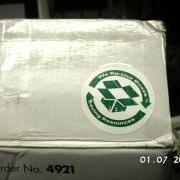Like many Californians we shop at our local farmer's market, turn off the lights, maintain our home, buy recycled goods and commute.
My husband and I put all of our data into the Cool Climate Calculator and found we are doing really well for an American and even substantially better than the average Californian, but our commutes undid a lot of the CO2 we were saving in other areas.
So, what to do? There is Commute.org that covers San Mateo County but we both commute out of the county and havnt had any luck on that web site yet. We do both take the bus/train sometimes, but for me, making multiple stops with heavy loads often makes it impossible and my husband lacks a good connection on the other end of his CalTrain trip.
But enough excuses, here are some of the things that we do practice.
Distance Travel. Different modes of transportation have different rates of pollution. Generally, from least to most it goes: Train, Car, then Airplane. Boats are hard to place because much of their effect on aquatic life is not as well understood but in straight miles per gallon they are the lowest by far. Airplane vs car can be tricky however because most cars are driven solo where as most planes are booked fairly full these days. According to Grist.org short flights are more consumptive than long flights. So a 300 mile trip by plane is about the same as a 300 mile trip by car solo. Thus if you are going more than 300 miles by yourself, you might want to fly. Who wants to drive that far solo anyway.
The general rule we use in planning our travel is: 0 to 5 miles = by bike or on foot, 5 to 100 miles away = by car, 100 miles to 700 miles = by train, any place farther than we can get in 1 day on the train we consider flying. That means we can get as far as LA or Portland by train but beyond that we fly only if needed. Amtrak even has a carbon offset program.
Our travel breaks down into 3 basic groups. Work, Family & Friends, shopping. Work is the easiest to get under control for most people because it involves a regular routine. Here are some things to think about when planning your shopping or family trips.
 Think about having it mailed. If you need some small item from a specially shop on the other side of the bridge, inquire about having it mailed. By the time you pay $4 for the toll, spend over an hour in traffic, add in gas and CO2 and you are probably going to be better off having it shipped and letting that treasure share its carbon foot print with 100 other boxes and keep someone employed to boot. Dont forget to ask the shop if they can find used materials to pack your item. I recently recieved a box with a reuse sticker on it. I thought it was cool.
Think about having it mailed. If you need some small item from a specially shop on the other side of the bridge, inquire about having it mailed. By the time you pay $4 for the toll, spend over an hour in traffic, add in gas and CO2 and you are probably going to be better off having it shipped and letting that treasure share its carbon foot print with 100 other boxes and keep someone employed to boot. Dont forget to ask the shop if they can find used materials to pack your item. I recently recieved a box with a reuse sticker on it. I thought it was cool.
Procrastinate. Why consume today what you can consume later. Often our needs resolve themselves when we aren't so egger to fulfill them at first impulse. Giving things time eliminates rush shopping trips to inconvenient places.
Plan far in advance. This is easy when you procrastinate. If you have a list of non-critical things you would like to acquire at some time in your future and reference this when planning your shopping, you will likely find that your shopping will start to organize itself. Planning far in advance and letting your friends know what you are up adds to the chances that you can share your car with someone you know. Online mapping programs allow you to look for other shopping options near your destination.
Group your shopping trips by location. Once you have a long term list and planned your trip, park your car near to where you are going to be buying the heaviest things and walk to the other near by stores you plan to visit. This helps you get to know the other shops in the areas you frequent and will save you a great deal of parking headaches. Beside, you pay to go to the gym dont you? Walking is free. Just leave yourself extra time and enjoy the day.
Cooperate with your friends. Most of us here in the Bay Area know many people over a wide area and have lived in more than one part of the Bay Area. If you find you need something from the far flung edges of the bay, or want to visit friends on the outer edges, think of whom you know that lives there, or might be heading that way. Friends are often willing to pick up thing for us especially if we are willing to do the same favor for them. Cell phone allows your friends to call from the store and take much of the "fear" out of letting someone else do your shopping. You can also introduce your friends to friends or meet their friends by carpooling on your social trips.
- Log in to post comments